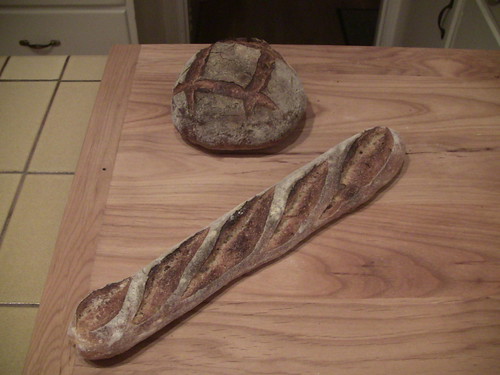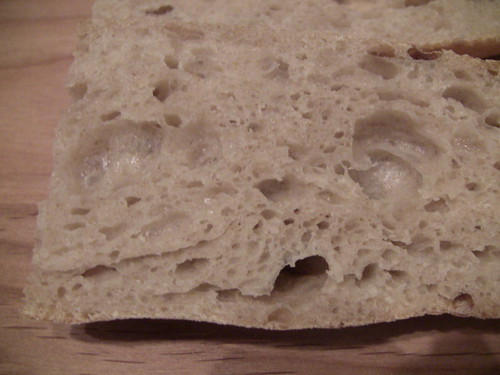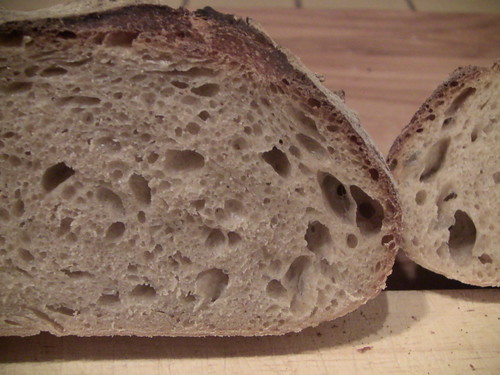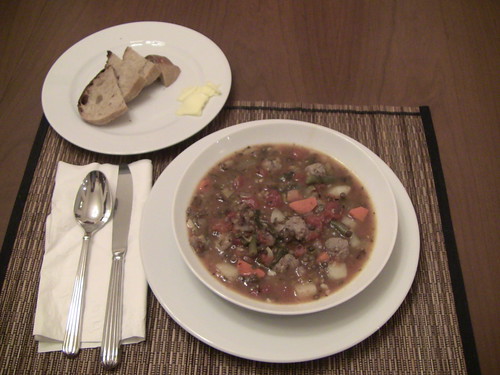I was very pleased with my San Francisco Country Sourdough a couple weeks ago (http://www.thefreshloaf.com/node/20228/shall-we-call-it-san-francisco-country-sourdough), but no formula is exempt from tweaking. This week I tweaked it as follows: (1) I used KA AP flour in place of KA European-Style Artisan Bread Flour; (2) I increased whole wheat from 6% to 8.5%; (3) I increased hydration from 66% to 67% in light of the increased whole wheat; (4) I refrigerated the dough for 17 hours after the 3 hour room-temperature primary fermentation; (5) I baked smaller loaves instead of two 750g boules; and (6) I went with the latest steaming craze. The tweaks led to improvement.

I don’t know if my starter was more active this week or loved the increased whole wheat or the water was a bit warmer or what, but the dough got somewhat larger and gassier in the primary fermentation than it did last time. There were many big bubbles in the dough when I put it in the fridge.
Right out of the fridge, the dough was divided into three 235g pieces for mini-baguettes. The remaining 815g piece was formed into two mini-boules. I decided to bake bats and balls in celebration of the Giants World Series Championship.
Bat and Ball 
Dividing the dough into appropriately shaped pieces was interesting. I ended up with three different shapes of mini-baguettes. I could have shaped them more uniformly, but I sort of let them shape themselves based on how they were divided, and this is what they wanted to do.
After carving off the mini-baguette pieces, I returned the rest of the dough to the fridge for another 90 minutes, so the mini-boules (baked after the mini-baguettes) started proofing around the time the mini-baguettes went into the oven. I had to leave time to re-heat the cast iron pan and lava rocks for the second bake.
After 75 minutes proofing, the mini baguettes were baked on the stone at 500F with steam for 10 minutes and dry at 475F for 12 minutes more.
The mini-boules proofed 90 minutes and were baked on the stone at 500F with steam for 12 minutes and dry at 460 for 16 minutes.
The steam was produced using the Sylvia’s-Luxury-Spa-Method-plus-good-old-cast-iron-pan-with-lava-rocks combination I used last week. My oven was exuding steam throughout the first 10 minutes, so there’s no doubt it was moist in there.
The results were very satisfactory. Like last time, the crust was thin and crispy and the crumb was light but chewy. The taste is a bit nuttier with the increased whole wheat. I like it so far and look forward to trying the “next day flavor”.
Baguettes 
Baguette Crumb
Boule Crumb
I had most of a mini-baguette for lunch and part of one mini-boule with my scrumptious “Greek Gumbo” (soup with lamb meatballs, lentils and vegetables) for dinner.

With my wife away, Tasha thinks she should join me at the table. “Just meatballs for me, thanks”.

Here’s the revised formula:
San Francisco Country Sourdough (Sourdough Pain de Campagne)
Yield: Two 750g Loaves or Three Mini-Baguettes (235g each) and one 800g Loaf or…
Ingredients
LIQUID-LEVAIN BUILD
100 grams AP flour
24 grams Whole Wheat flour
12 grams Whole rye flour
170 grams Water, luke warm
28 Mature culture (75% hydration)
FINAL DOUGH (67% hydration, including levain)
660 grams KAF All-Purpose flour (85.5%)
65 grams Whole wheat flour (8.5%)
45 grams Whole rye flour (6%)
435 grams Water at room temperature (56%)
17 grams Salt (2%)
306 Liquid levain (40%)
Directions
1. LIQUID LEVAIN: Make the final build 12 to 16 hours before the final mix, and let stand in a covered container at about 70°F
2. MIXING: Add all the ingredients to the mixing bowl, including the levain, but not the salt. Mix just until the ingredients are incorporated into a shaggy mass. Correct the hydration as necessary. Cover the bowl with plastic and let stand for an autolyse phase of 30 to 60 minutes. At the end of the autolyse, sprinkle the salt over the surface of the dough, and finish mixing 5 minutes. The dough should have a medium consistency.
3. BULK FERMENTATION WITH S&F: 3 hours. Stretch and fold the dough in the bowl twice 30-strokes at 45-minute intervals. Place dough ball in lightly oiled bowl, and stretch and fold on lightly floured board at 45 minutes. If the dough has not increased in size by 75% or so, let it go a bit longer.
4. RETARDED BULK FERMENTATION (optional): After second S&F on board, form dough into ball and then place again in lightly oiled bowl. Refrigerate 8-20 hours, depending on sourness desired and scheduling convenience.
5. DIVIDING AND SHAPING: Divide the dough into pieces and pre-shape. Let sit on board for 30-45 minutes, and then shape into boules or batards or baguettes.
6. PROOFING: Approximately 1.5 to 2.5 hours at 72° F. Ready when poke test dictates. Pre-heat oven to 500 with steam apparatus in place.
7. BAKING: With steam, on stone. Turn oven to 460 °F after it hits 500F after loading loaves. Remove steaming apparatus after 12 minutes (10 for baguettes). Bake for 35 to 40 minutes total (for 750g loaves; less for smaller loaves). Rotate loaves for evenness as necessary. When done (205 F internal temp), leave loaves on stone with oven door ajar 10 minutes.
Happy Baking!
Glenn
Submitted to Yeast Spotting (http://www.wildyeastblog.com/category/yeastspotting)